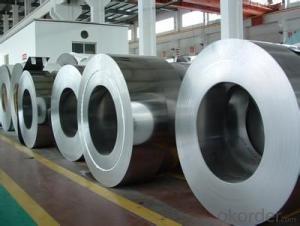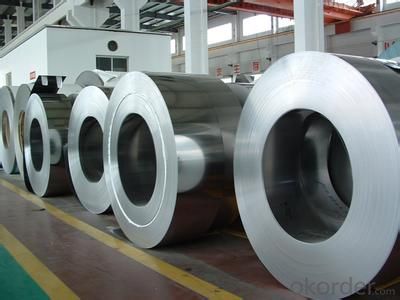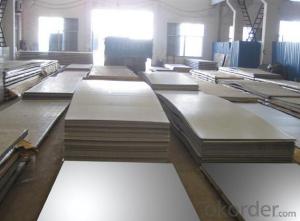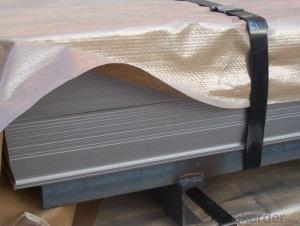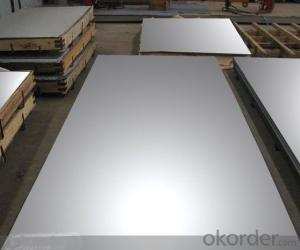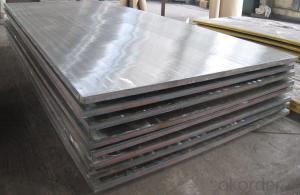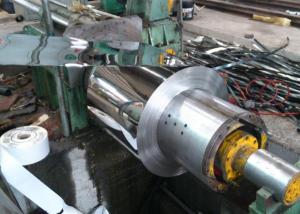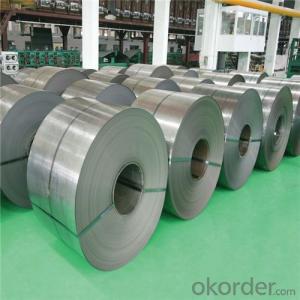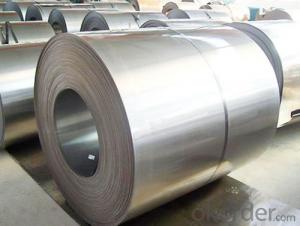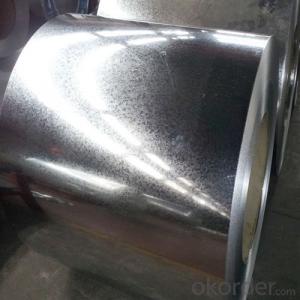High Qualit Stainless Steel Coil
- Loading Port:
- China Main Port
- Payment Terms:
- TT OR LC
- Min Order Qty:
- -
- Supply Capability:
- -
OKorder Service Pledge
OKorder Financial Service
You Might Also Like
Quick Details
· Grade: 300 Series
· Standard: JIS, AISI, ASTM, GB, DIN, EN
· Length: Aaccording to clients's requirement
· Thickness: 0.20~4.0 or according to clients's requirement
· Width: 1200mm or according to clients' requirement
· Place of Origin: China (Mainland)
· Model Number: SUS 201 304 316 430
· Type: Coil
· Application: Household stainless steel ect
· Certification: ISO
· Thickness: 0.20~4.0 or annealing according to clients's requirement
Packaging & Delivery
| Packaging Details: | Standard export packing with wooden pallet or according to the customer's request. |
|---|---|
| Delivery Detail: | 20 - 25 days after deposit |
- Q: Can stainless steel sheets be used for electrical conductivity?
- Typically, stainless steel sheets are not employed for electrical conductivity. Stainless steel is renowned for its exceptional resistance to corrosion and durability, rendering it apt for a diverse range of applications like kitchen appliances, construction materials, and industrial equipment. Nevertheless, stainless steel falls short in terms of conductivity compared to metals such as copper or aluminum. Consequently, materials with superior electrical conductivity properties are commonly preferred for electrical purposes.
- Q: Several processing techniques of colored stainless steel
- Sand blasting, sand blasting can be plated color, but the color of the plating and ordinary plating color difference exists, mainly due to sand blasting particles for emery. The color stainless steel sand blasting plate is made of zirconium beads through the mechanical equipment in the stainless steel plate surface, so that the surface of the board presents small beads, grainy sand surface, forming a unique decorative effect. Uses: mainly used in architectural decoration, elevator decoration, industrial decoration, facilities, decoration and other stainless steel products.
- Q: What is the weight of a stainless steel sheet?
- The weight of a stainless steel sheet depends on its dimensions (length, width, and thickness).
- Q: Can stainless steel sheets be used for decorative panels?
- Yes, stainless steel sheets can definitely be used for decorative panels. Stainless steel is known for its durability, strength, and resistance to corrosion, making it an excellent choice for decorative purposes. It is widely used in interior design, architecture, and various industries for its aesthetic appeal. Stainless steel sheets can be customized with different finishes, such as brushed, polished, or patterned, to create unique and visually appealing decorative panels. Additionally, stainless steel sheets can be easily cut, shaped, and formed into various designs, making them versatile for different decorative applications. Whether it is for wall cladding, elevator interiors, furniture accents, or signage, stainless steel sheets offer a modern, sleek, and sophisticated look that enhances the overall aesthetics of any space.
- Q: What is the difference between brushed and polished stainless steel sheets?
- The appearance and texture of brushed and polished stainless steel sheets vary. Brushed sheets have a matte finish achieved by brushing the surface with an abrasive material, which creates parallel lines or patterns. This finish helps conceal scratches and fingerprints, making it popular for durable applications. On the other hand, polished sheets have a glossy finish achieved by polishing with a fine abrasive compound. This process eliminates imperfections and scratches, resulting in a mirror-like reflection. The polished finish is more visually appealing and commonly used for decorative purposes. In summary, the main distinction between brushed and polished stainless steel sheets lies in their appearance and texture. Brushed sheets have a textured, matte finish that is more resistant to scratches and fingerprints, while polished sheets have a smooth, glossy finish that provides a mirror-like reflection. The choice depends on the desired aesthetic and specific application requirements.
- Q: How do you prevent stress corrosion cracking in stainless steel sheets?
- Several measures can be implemented to prevent stress corrosion cracking in stainless steel sheets. Firstly, it is crucial to select the appropriate grade of stainless steel that is resistant to stress corrosion cracking. While commonly used grades like 304 and 316 have good resistance, more aggressive environments may require specialized alloys such as duplex stainless steels or high nickel alloys. In addition, controlling the environment surrounding the stainless steel sheets is important. This involves avoiding exposure to corrosive agents like chlorides, sulfides, and acids. Proper pH levels and temperature should also be maintained to minimize the risk of stress corrosion cracking. Proper fabrication and handling techniques should be followed to prevent the introduction of stress that can lead to cracking. Unnecessary bending, cold working, or overloading should be avoided. Proper storage and handling techniques should also be employed to prevent surface contamination or damage that may facilitate stress corrosion cracking. Applying protective coatings or passivation treatments can enhance the corrosion resistance of stainless steel sheets. These treatments create a passive oxide layer on the surface that acts as a barrier against corrosive agents, reducing the risk of stress corrosion cracking. Stress relief heat treatment can be performed on stainless steel sheets to remove residual stresses induced during fabrication. This involves heating the sheets to a specific temperature and holding it for a certain period, followed by slow cooling. Stress relief heat treatment helps to minimize the risk of stress corrosion cracking by reducing internal stress levels. Regular inspection and maintenance are essential to identify any signs of stress corrosion cracking at an early stage. This allows for timely repairs or replacements to prevent further damage. Proper maintenance practices such as cleaning, removing deposits, and ensuring proper drainage can also contribute to the prevention of stress corrosion cracking. By following these preventive measures, the risk of stress corrosion cracking in stainless steel sheets can be significantly reduced, ensuring the durability and integrity of the material in various applications.
- Q: What is called anti fingerprint stainless steel sheet?
- Anti fingerprint (also known as non fingerprint) stainless steel plate is a protective layer treatment process is extremely thin and solid formed on the surface of stainless steel by nano coating technology, the stainless steel surface can not only achieve the anti fingerprint effect, but also can improve the ability of anti corrosion; and processing, such as bending or stamping processing can meet the general request.
- Q: Are stainless steel sheets suitable for outdoor furniture?
- Yes, stainless steel sheets are highly suitable for outdoor furniture. Stainless steel is known for its exceptional durability and resistance to corrosion, making it an ideal material for withstanding outdoor elements such as rain, sunlight, and temperature changes. Stainless steel sheets are also easy to clean and maintain, requiring minimal effort to keep them looking new. Additionally, stainless steel has a sleek and modern appearance that can enhance the aesthetic appeal of outdoor furniture. Overall, stainless steel sheets offer the perfect combination of strength, longevity, and visual appeal, making them a great choice for outdoor furniture.
- Q: What is the strain hardening exponent of stainless steel sheets?
- The ability of stainless steel sheets to increase their strength and hardness as they undergo plastic deformation or strain is referred to as the strain hardening exponent. This exponent measures how the stress-strain curve of the material changes as deformation increases. Typically, stainless steel sheets have a strain hardening exponent ranging from 0.2 to 0.4. This value signifies that the material experiences a moderate increase in strength and hardness when subjected to plastic deformation. A higher strain hardening exponent indicates a greater resistance to deformation and better ability to maintain its shape under external forces. The strain hardening exponent plays a crucial role in engineering applications as it impacts the material's formability, ductility, and resistance to deformation. Materials with higher strain hardening exponents are preferred in industrial processes like sheet metal forming or cold working as they offer enhanced work-hardening properties. However, excessively high strain hardening exponents can lead to issues such as cracking or material failure. It is important to acknowledge that the strain hardening exponent can vary depending on the specific grade and composition of the stainless steel alloy. Different stainless steel alloys may exhibit distinct strain hardening behaviors, necessitating consideration of the material's properties and specifications when determining the strain hardening exponent for a particular stainless steel sheet.
- Q: Can stainless steel sheets be used for architectural canopies?
- Yes, stainless steel sheets can be used for architectural canopies. Stainless steel is a durable and corrosion-resistant material that can withstand outdoor elements, making it suitable for use in canopies. It offers a sleek and modern appearance and can be customized to fit various design requirements.
Send your message to us
High Qualit Stainless Steel Coil
- Loading Port:
- China Main Port
- Payment Terms:
- TT OR LC
- Min Order Qty:
- -
- Supply Capability:
- -
OKorder Service Pledge
OKorder Financial Service
Similar products
Hot products
Hot Searches
Related keywords
